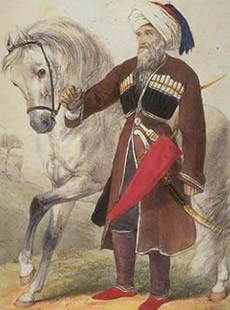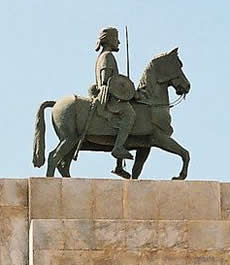World History
Popularly known as the Gran or Ahmed, the Left-handed, Ahmed ibn Ghazi, the king of Adal, was a Somali general who, after establishing an inland Muslim empire, laid siege to Ethiopia in 1529 in an attempt to wipe out Christianity and establish Ethiopia as a Muslim state.
Christian Ethiopia was particularly vulnerable to outside attacks from neighboring Muslim countries because from 1478 to 1527, the average age of Ethiopian rulers was only 11. The Sultanate of Harar, which was heavily Muslim, repeatedly attempted to overtake Ethiopia. Around 1500, zealous Muslims announced the onset of a jihad (holy war) in which Islam was to be instated throughout Africa.
In the late 1520s, the sultanate’s position was reinforced by the Islamization of Somali, which was effected by the concentrated efforts of Turkish and Arab adventurers. Consequently, Harar’s troops, led by Ahmed ibn Ghazi, attacked Ethiopia in 1529. Ahmed’s forces were reinforced by the recently conquered Chushitic troops who hoped to gain their freedom by fighting with Ahmed’s forces.
Ahmed triumphed during the Battle of Amba Sel on October 28, 1531. By the following year, he had succeeded in gaining control of Ethiopia and had forced Ethiopian emperor Lebna Dengel (1508–40) into hiding. Ahmed subsequently established himself as the ruler of Ethiopia. He was a vengeful conqueror, brutally destroying land and churches and devastating the Ethiopian people.
Once he was in power, Ahmed proceeded with his attempts to eradicate Christianity from Ethiopia. He even destroyed the Church of Our Lady Mary of Zion where Ethiopian emperors had been crowned for centuries. At swordpoint, Ahmed’s troops ordered Ethiopian Christians to renounce their faith and swear allegiance to the Muslim faith instead.
Ahmed also executed a Portuguese commander who refused to convert to Islam. Although appearing to comply with Ahmed’s orders, the Ethiopian Christians, including Emperor Lebna Dengel, continued to adhere to the Christian faith. When Ahmed ordered the emperor to command his daughter to marry him, Lebna Dengel defied him and refused to have his daughter marry a nonbeliever.
On September 2, 1540, Ahmed succeeded in tracking Lebna Dengel to the monastery of Dabra Dam in Tigre, where the emperor was killed in battle. However, the emperor’s earlier request for military assistance from Portugal had finally resulted in the arrival of 400 Portuguese musketeers in Ethiopia under the leadership of Christovao da Gama, the son of Portuguese explorer Vasco da Gama.
In addition to the Portuguese, the Ethiopians had been reinforced by large numbers of Oromo (Galla) people, who threw considerable force into destroying Islamic communities and attacking the invaders.
While generally successful in their attacks on Ahmed’s troops, da Gama and 140 of his troops were killed in a battle north of the Tekez River. After Lebna Dengel’s death, his son Galawdewos, who had succeeded to the Ethiopian throne, led an attack on Ahmed’s forces on February 21, 1543.
In what became known as the Battle of Wayna Daga, a Portuguese musketeer who was determined to avenge the death of da Gama and his comrades killed Ahmed, even though it cost him his own life. Once Ahmed was dead, his troops lost the will to continue the jihad. As a result of the Battle of Wayna Daga and Ahmed’s death, Galawdewos was able to restore the Ethiopian Empire.
The Ethiopian Christians celebrated their restoration to power by holding ceremonies in which they publicy renounced the Muslim faith and reembraced Christianity. Despite this success, Galawdewos’s reign was cut short when he was killed in one of the frequent raids conducted by Bati Del Wambara, Ahmed’s widow, who was determined to avenge her husband’s death.
During the years of Muslim occupation, much of Ethiopia had been destroyed. Ethiopia has survived as an African nation with a considerable Christian presence. Currently, between 35 and 40 percent of the Ethiopian population belong to the Ethiopian Orthodox Church, and between 45 and 50 percent embrace the Muslim faith.
- Ethiopian Empire
stele in AxumEthiopia’s unique and venerable identity stems from its claims to have deep roots in the ancient and biblical world. On one hand it continued the ancient civilization represented by Axum, the trading intermediary for Rome and India...
- Koprülü Family
Koprülü Family Four different members of the Koprülü family served as grand viziers in the Ottoman Empire during the 17th century. Of obscure Albanian origins, Mohammad Koprülü had a fairly inauspicious career in the vast Ottoman bureaucracy...
- Q&a: Horn's Bitter Border War
Q&A: Horn's bitter border war. This article examines the main issues behind the 1998-2000 border conflict between Ethiopia and Eritrea, the problem of determining a boundary between the nations after the Algiers peace settlement, and the role of...
- Appeal To The League Of Nations
Appeal to the League of Nations - A speech Emperor Haile Selassie delivered to the League of Nations in June of 1936 in Geneva. Fascist Italy had invaded Ethiopia and the resulting Italo-Ethiopian War was a disaster for the Africans. From the site: "I,...
- Ethiopian History 500bc - 1996
Ethiopian History 500bc - 1996 - Introductory topics of Ethiopian history including Aksum, Zagwe Dynasty, Solomonic Dynasty, contacts with Europeans, Gondar, Tewodros, Menelik II, Haile Selassie, and modern history. From the site: Where to start...
World History
Ahmed ibn Ghazi
 |
| Ahmed ibn Ghazi |
Christian Ethiopia was particularly vulnerable to outside attacks from neighboring Muslim countries because from 1478 to 1527, the average age of Ethiopian rulers was only 11. The Sultanate of Harar, which was heavily Muslim, repeatedly attempted to overtake Ethiopia. Around 1500, zealous Muslims announced the onset of a jihad (holy war) in which Islam was to be instated throughout Africa.
In the late 1520s, the sultanate’s position was reinforced by the Islamization of Somali, which was effected by the concentrated efforts of Turkish and Arab adventurers. Consequently, Harar’s troops, led by Ahmed ibn Ghazi, attacked Ethiopia in 1529. Ahmed’s forces were reinforced by the recently conquered Chushitic troops who hoped to gain their freedom by fighting with Ahmed’s forces.
Ahmed triumphed during the Battle of Amba Sel on October 28, 1531. By the following year, he had succeeded in gaining control of Ethiopia and had forced Ethiopian emperor Lebna Dengel (1508–40) into hiding. Ahmed subsequently established himself as the ruler of Ethiopia. He was a vengeful conqueror, brutally destroying land and churches and devastating the Ethiopian people.
Once he was in power, Ahmed proceeded with his attempts to eradicate Christianity from Ethiopia. He even destroyed the Church of Our Lady Mary of Zion where Ethiopian emperors had been crowned for centuries. At swordpoint, Ahmed’s troops ordered Ethiopian Christians to renounce their faith and swear allegiance to the Muslim faith instead.
Ahmed also executed a Portuguese commander who refused to convert to Islam. Although appearing to comply with Ahmed’s orders, the Ethiopian Christians, including Emperor Lebna Dengel, continued to adhere to the Christian faith. When Ahmed ordered the emperor to command his daughter to marry him, Lebna Dengel defied him and refused to have his daughter marry a nonbeliever.
On September 2, 1540, Ahmed succeeded in tracking Lebna Dengel to the monastery of Dabra Dam in Tigre, where the emperor was killed in battle. However, the emperor’s earlier request for military assistance from Portugal had finally resulted in the arrival of 400 Portuguese musketeers in Ethiopia under the leadership of Christovao da Gama, the son of Portuguese explorer Vasco da Gama.
In addition to the Portuguese, the Ethiopians had been reinforced by large numbers of Oromo (Galla) people, who threw considerable force into destroying Islamic communities and attacking the invaders.
While generally successful in their attacks on Ahmed’s troops, da Gama and 140 of his troops were killed in a battle north of the Tekez River. After Lebna Dengel’s death, his son Galawdewos, who had succeeded to the Ethiopian throne, led an attack on Ahmed’s forces on February 21, 1543.
 |
| Ahmed ibn Ghazi statue |
The Ethiopian Christians celebrated their restoration to power by holding ceremonies in which they publicy renounced the Muslim faith and reembraced Christianity. Despite this success, Galawdewos’s reign was cut short when he was killed in one of the frequent raids conducted by Bati Del Wambara, Ahmed’s widow, who was determined to avenge her husband’s death.
During the years of Muslim occupation, much of Ethiopia had been destroyed. Ethiopia has survived as an African nation with a considerable Christian presence. Currently, between 35 and 40 percent of the Ethiopian population belong to the Ethiopian Orthodox Church, and between 45 and 50 percent embrace the Muslim faith.
- Ethiopian Empire
stele in AxumEthiopia’s unique and venerable identity stems from its claims to have deep roots in the ancient and biblical world. On one hand it continued the ancient civilization represented by Axum, the trading intermediary for Rome and India...
- Koprülü Family
Koprülü Family Four different members of the Koprülü family served as grand viziers in the Ottoman Empire during the 17th century. Of obscure Albanian origins, Mohammad Koprülü had a fairly inauspicious career in the vast Ottoman bureaucracy...
- Q&a: Horn's Bitter Border War
Q&A: Horn's bitter border war. This article examines the main issues behind the 1998-2000 border conflict between Ethiopia and Eritrea, the problem of determining a boundary between the nations after the Algiers peace settlement, and the role of...
- Appeal To The League Of Nations
Appeal to the League of Nations - A speech Emperor Haile Selassie delivered to the League of Nations in June of 1936 in Geneva. Fascist Italy had invaded Ethiopia and the resulting Italo-Ethiopian War was a disaster for the Africans. From the site: "I,...
- Ethiopian History 500bc - 1996
Ethiopian History 500bc - 1996 - Introductory topics of Ethiopian history including Aksum, Zagwe Dynasty, Solomonic Dynasty, contacts with Europeans, Gondar, Tewodros, Menelik II, Haile Selassie, and modern history. From the site: Where to start...
